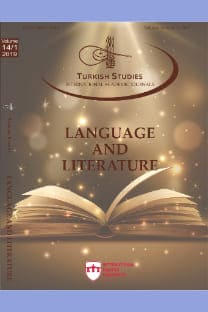Prejudiced Occidental Perspective toward an Oriental City: Istanbul in the Eyes of Paul Bowles
This article explores the short travel text written by American writer Paul Bowles about Istanbul in his book Their Heads are Green and their Hands are Blue (1957) under the essay titled “A Man Must Not be very Moslem” (1953). This paper seeks to explore American author Paul Bowles’ travel text about Istanbul in 1953. All travel writing has a two-way aspect. It first provides a report on the wider world, while also providing information about an alien person or a place. However, it also reveals in some way the traveller’s values, concerns and assumptions. It also gives away something about the culture in which the author originated and / or the culture for which his text is intended. Accordingly, to begin with, travel literature in general and limitations of the genre is explained briefly. Thereafter, the concepts of orientalism and the effects of orientalist stereotypes are discussed. In the scope of Orientalism Edward Said argues that Asia, Turks and Islam have been stereotyped by the West. The orientalist generalization of the Turkish image has led to the alienation and exclusion of the Turks, East and Islam. For this purpose, many Europeans and Westerners alike have been comparing Hellenic cultural accumulation which is the constituent of European identity with the Islamic cultural background of the Turks. In the light of this information, Paul Bowles comes to Istanbul with the orientalist bigotry. In search of an exotic city, Bowles could not find what he is looking for in Istanbul. Instead, he is disappointed when he has noticed the half-east and half-west side of Istanbul because he regards the westernization of nations as a threat to their cultural past, although he is influenced from an orientalist point of view.
Önyargılı Batılı Perspektifinden bir Doğu Şehri: Paul Bowles’in Gözünden İstanbul
Bu makale Amerikalı yazar olan Paul Bowles’ın İstanbul hakkında 1953'te “A Man Must Not Be Vey Moslem” başlığıyla Their Heads are Greeen and Their Hands are Blue (1957) adlı kitabında kaleme aldığı kısa gezi metnini araştırmayı amaçlamaktadır. Tüm Seyahat yazılarının iki yönlü bir yönü vardır. İlk önce daha geniş bir dünya hakkında bir rapor sunarken, aynı zamanda yabancı bir kişi veya bir yer hakkında bilgi sağlar. Bununla birlikte, bir şekilde yolcunun değerlerini, endişelerini ve varsayımlarını da ortaya koymaktadır. Ayrıca, yazarın ortaya çıktığı kültür ve / veya metninin amaçlandığı kültür hakkında bir şeyler verir. Buna göre, başlangıç olarak, genel hatlarıyla gezi edebiyatı ve türün kısıtlamaları kısaca açıklanmaktadır. Daha sonra, Şarkiyat kavramı ve Şarkiyatçı klişelerin etkileri tartışılmaktadır. Şarkiyatçılık kapsamında Edward Said Asya, Türkler ve İslam'ın Batı tarafından basmakalıp bir şablona oturtulduğunu savunmaktadır. Türk imajının oryantalist genellemesi, Türklerin, Doğu'nun ve İslam'ın, yabancılaştırılmasına ve dışlanmasına yol açtmıştır. Bu amaçla, birçok Avrupalı ve Batılı, Avrupa kimliğinin kurucusu olan Yunan kültürel birikimini Türklerin İslami kültürel geçmişi ile karşılaştırmaktadır. Bu bilgiler ışığında Paul Bowles, oryantalist bakış açısıyla İstanbul'a geliyor. Egzotik bir kent bulma arayışında olan Bowles, İstanbul'da aradıklarını bulamıyor. Bunun yerine, İstanbul'un yarı doğu ve yarı batı tarafını fark ettiğinde hayal kırıklığına uğramıştır çünkü her ne kadar oryantalist bakış açısından etkilenmiş olsa da ulusların batılılaşmasını kültürel geçmişleri için bir tehdit olarak görmektedir.
___
Allison, R. J. (1995). The crescent obscured: The United States and the Muslim world, 1776–1815. Oxford University PressBowles, P. (2010). Travels: Collected writing 1950-1993. Ecco. Çöl Marjinali Paul Bowles Öldü, (1999, November 20) https://www.hurriyet.com.tr/gundem/colmarjinali-paul-bowles-oldu-39114568
Fortuny, K. (2009) American writers in Istanbul. Syracuse University Press.
Fussel, P. (editor) (1987). The Norton Book of travel. W.W. Norton&Company. 575-590
Holland, P. & Huggan, G. (2000). Tourists with typewriters: Critical reflections on contemporary travel writing. The University of Michigan Press.
Hulme P. & Youngs T. (editors) (2002) The Cambridge companion to travel writing. Cambridge University Press. 105-122.
Kabbani, Rana (1986) Europe’s myths of orient: Devise and rule. Macmillan Press LTD.
Kinross, L. (1979). The Ottoman centuries: The rise and fall of the Turkish Empire. Morrow Quill Paperbacks.
Knolles, R. (1603). The generall historie of the Turkes.
Kula, O. B. (2011) Batı edebiyatinda oryantalizm ve Türk imgesi volumes I&II. Türkiye İş Bankası
Lewis, B. (1994). Islam and the West. Oxford University Press.
_____________ (2004). The crisis of Islam: Holy war and unholy terror. Phoenix
Little, D. (2008). American orientalism: The United States and the Middle East since 1945. The University of North Carolina Press
Özbaran, Salih (editor) (2003). V.J. Parry Richard Knolles’ history of the Turks. The Economic and Social History Foundation of Turkey.
Pratt, M. L. (1992) Imperial eyes: Travel writing and transculturation. Routledge.
Said, E. W. (1979). Orientalism (25th anniversary edition). Vintage Books.
_____________ (1994). Culture and imperialism. Vintage Books
Senlen, S. (2005). “Richard Knolles’ The generall historie of the Turkes as a reflection of Christian historiography”. OTAM Journal of Ankara University, 18, 379-393.
Speake, J. (editor) (2013). Literature of travel and exploration: An Encyclopedia Volume One A to F. Routledge
Spurr, D. (1993). The rhetoric of empire: Colonial discourse in journalism, travel writing, and imperial administration., Duke University Press
Thompson, C. (2011). Travel writing. Routledge.
- ISSN: 2667-5641
- Yayın Aralığı: Yılda 4 Sayı
- Başlangıç: 2006
- Yayıncı: ASOS Eğitim Bilişim Danışmanlık Otomasyon Yayıncılık Reklam Sanayi ve Ticaret LTD ŞTİ
Sayıdaki Diğer Makaleler
A New Historicist Approach to “My Name is Red” Novel of Orhan Pamuk
Sevim Ak’ın Çocuk Romanlarında Toplumsal Cinsiyet Rolleri Üzerine Bir İnceleme
Women Without Identity in the Story Evli Evinde* by Hulki Aktunç
Metinlerarası Bağlamda Murathan Mungan’ın Dokuz Anahtarlı Kırk Oda İsimli Öykü Kitabı
Bursalı Hasîb’in Manzum Bir Aşk Hikâyesi
Mehmet GÜRBÜZ, Fatma Sabiha KUTLAR OĞUZ
Cultural Transfer in Dede Korkut Stories Published by Yunus Emre Institute
In Regard to a New Copy of Çeng-nâme
Ansichten der StudentInnen zur Verwendung landeskundlicher Elemente im Deutschunterricht
